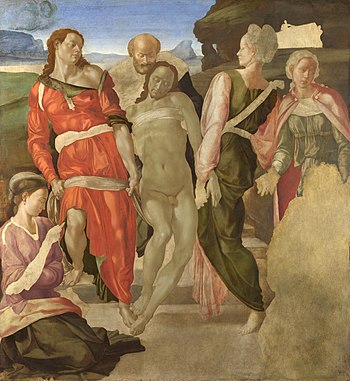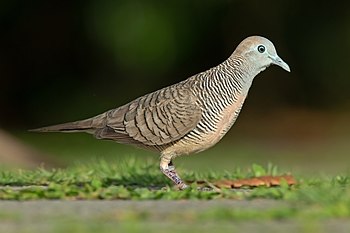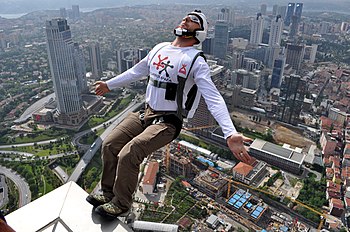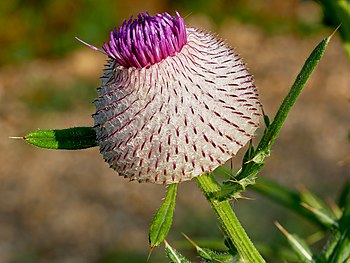Wikipedia:Picture of the day/April 2021
|
Featured picture tools: |
These featured pictures, as scheduled below, appeared as the picture of the day (POTD) on the English Wikipedia's Main Page in April 2021. Individual sections for each day on this page can be linked to with the day number as the anchor name (e.g. [[Wikipedia:Picture of the day/April 2021#1]] for April 1).
You can add an automatically updating POTD template to your user page using {{Pic of the day}} (version with blurb) or {{POTD}} (version without blurb). For instructions on how to make custom POTD layouts, see Wikipedia:Picture of the day.
April 1

|
My Wife's Lovers is an 1891 painting by Austrian artist Carl Kahler depicting forty-two Turkish Angora cats belonging to American millionaire Kate Birdsall Johnson. Not having painted cats before, Kahler spent three years studying cat poses and learning their habits. At the center of the painting sits Sultan, bought by Johnson during a trip to Paris. She lent the painting to the 1893 Chicago World's Fair and, following her death, it was acquired by Ernest Haquette for his Palace of Art Salon in San Francisco. Kahler died in the 1906 San Francisco earthquake, and the salon where the painting was hung was destroyed, but the picture survived. It was sold at Sotheby's in 2015 to a private buyer from California. Painting credit: Carl Kahler
Recently featured:
|
April 2

|
The Entombment is an unfinished oil-on-panel painting of the burial of Jesus, now generally attributed to the Italian painter Michelangelo and dated to around 1500 or 1501. John the Evangelist may be the figure on the left, carrying Christ's body on strips of winding cloth up steps to the tomb, helped by one of the three Marys. The figure behind may be Joseph of Arimathea or Nicodemus, while another Mary sits on the ground at the bottom left. The unfinished area at bottom right was intended for a kneeling figure of the Virgin Mary. The painting is in the collection of the National Gallery in London. Painting credit: Michelangelo (attributed)
Recently featured:
|
April 3

|
The zebra dove (Geopelia striata) is a species of bird in the family Columbidae, native to southeastern Asia. Unlike other doves, zebra doves tend to forage alone or in pairs. Their diet consists mostly of grass and weed seeds, and they will also eat insects and other small invertebrates. They prefer to forage on bare ground, short grass or on roadsides, scurrying about with rodent-like movement. Their grey-and-brown barred plumage camouflages them well when they are on the ground. This zebra dove was photographed in the Chinese Garden in Singapore. Photograph credit: John Harrison
Recently featured:
|
April 4

|
Étienne Maurice Gérard (4 April 1773 – 17 April 1852) was a French general, statesman and marshal of France. He served under a succession of French governments, including the monarchy of the Ancien Régime, the First Republic, the First Empire, the Bourbon Restoration, the July Monarchy, the Second Republic, and arguably the Second Empire, becoming prime minister briefly in 1834. This 1816 portrait of Gérard by Jacques-Louis David is in the collection of the Metropolitan Museum of Art in New York City. Painting credit: Jacques-Louis David
Recently featured:
|
April 5

|
Eunice Pinney (1770–1849) was an American folk artist active in the towns of Windsor and Simsbury, Connecticut. According to art historian Jean Lipman, a specialist in American folk painting, Pinney and her contemporary Mary Ann Willson are considered two of the earliest American painters to work in the medium of watercolor. This painting, entitled Lolotte et Werther, depicts a scene from Goethe's popular novel The Sorrows of Young Werther, and is in the collection of the National Gallery of Art in Washington, D.C. Painting credit: Eunice Pinney
Recently featured:
|
April 6

|
The inauguration of John Tyler as the tenth president of the United States took place on April 6, 1841, in Washington, D.C., following the death of President William Henry Harrison two days earlier. This was the first non-scheduled, extraordinary presidential inauguration to take place in American history. Having received news of Harrison's death, Tyler traveled to Washington from his home in Williamsburg, Virginia by steamboat and train, the fastest means of conveyance then available, taking 21 hours. Engraving credit: Bureau of Engraving and Printing; restored by Andrew Shiva
Recently featured:
|
April 7

|
Danaus genutia, the common tiger or striped tiger, is a species of brush-footed butterfly found in Sri Lanka, India, Myanmar, south-eastern Asia and Australia. It prefers areas of moderate to heavy rainfall, and typical habitats include scrubby jungle, deciduous forests and fallow land near habitations. The insect sequesters toxins from plants, and advertises its unpalatability by having prominent markings and striking colour patterns. This adult male common tiger, of the subspecies D. g. genutia, was photographed in Kerala, India. Photograph credit: Charles James Sharp
Recently featured:
|
April 8

|
The Hunting of the Snark is a nonsense poem written by English writer Lewis Carroll between 1874 and 1876. The plot follows a crew of ten trying to hunt the Snark, which may turn out to be a highly dangerous Boojum. This original illustration by Henry Holiday accompanies the verse:
Illustration credit: Henry Holiday; restored by Adam Cuerden
Recently featured:
|
April 9

|
BASE jumping is the recreational sport of jumping from fixed objects, using a parachute to descend safely to the ground. The acronym stands for four categories of fixed objects from which the jumps can be made: buildings, antennae, spans, and earth (cliffs). In this photograph, a BASE jumper launches himself from the top of the Sapphire Tower in Istanbul, Turkey. Photograph credit: Kontizas Dimitrios
Recently featured:
|
April 10

|
The red-billed streamertail (Trochilus polytmus) is the most common hummingbird in Jamaica, where it is the national bird. The female, shown here in hovering flight, lacks the red bill and long tail streamers of the male. The species's diet consists of nectar and small insects caught on the wing. Photograph credit: Charles James Sharp
Recently featured:
|
April 11

|
Wheat Fields is a series of dozens of paintings by Dutch artist Vincent van Gogh. Ploughed Fields ('The Furrows'), painted in 1888, shows a field after ploughing with the earth lying in rough clods before the wheat has been sown. The picture is in the collection of the Van Gogh Museum in Amsterdam. Painting credit: Vincent van Gogh
Recently featured:
|
April 12

|
The John F. Kennedy Space Center on Merritt Island, Florida, is NASA's primary launch center of human spaceflight. Launch operations for the Apollo, Skylab and Space Shuttle programs were carried out here. This photograph shows Space Shuttle Atlantis at Kennedy Space Center Launch Complex 39A in the evening before the launch of STS-129, a mission to the International Space Station in November 2009. Photograph credit: NASA / Bill Ingalls; retouched by Bammesk
Recently featured:
|
April 13

|
Hurdling is the act of running over an obstacle at high speed or in a sprint. It is a highly specialized form of obstacle racing, and forms part of track and field in the sport of athletics. In hurdling events, barriers known as hurdles are set at precisely measured heights and distances. This photograph shows the Austrian athlete Leon Okafor taking part in the men's 110-metre (120 yd) hurdles at the Leichtathletik Gala in Linz in 2018. Photograph credit: Isiwal
Recently featured:
|
April 14

|
Frederick Fleet (1887–1965) was a British sailor, crewman and survivor of the sinking of the Titanic after the ship struck an iceberg in the North Atlantic at 11:40 pm on 14 April 1912. As one of two lookouts on duty aboard the Titanic at the time of the collision, it was Fleet who first sighted the iceberg, ringing the bridge to proclaim: "Iceberg, right ahead!" Photograph credit: unknown
Recently featured:
|
April 15

|
Carol W. Greider (born April 15, 1961) is an American molecular biologist. She completed her PhD in 1987 at the University of California, Berkeley, under Elizabeth Blackburn. Their research focused on telomeres, with which the ends of chromosomes are tipped, and they discovered the enzyme telomerase which replenishes the tips and determines the life span of the cell. For these discoveries, she shared the 2009 Nobel Prize in Physiology or Medicine with Blackburn and Jack W. Szostak. Photograph credit: Keith Weller; edited by Adam Cuerden
Recently featured:
|
April 16

|
Charles J. Folger (April 16, 1818 – September 4, 1884) was an American lawyer and politician. He was a Republican member of the New York State Senate from 1862 to 1869, serving as president pro tempore for four years. In 1870, he was elected one of the first judges of the re-organized New York Court of Appeals. He became the chief judge, but resigned in 1881 to serve as United States Secretary of the Treasury. Engraving credit: Bureau of Engraving and Printing; restored by Andrew Shiva
Recently featured:
|
April 17

|
Clavulinopsis sulcata is a clavarioid fungus that grows on the ground among plant litter. First described from South Africa, it is also found in North America, Asia and Australasia. This clump of C. sulcata was photographed near the Lane Cove River in New South Wales, Australia. Photograph credit: John Harrison
Recently featured:
|
April 18

|
Booker T. Washington (1856–1915) was an American educator, author, narrator, and adviser to multiple presidents of the United States. Born into slavery, he became the leading voice of former slaves and their descendants, and was one of the founders of the National Negro Business League. His long-term goal was to end the disenfranchisement of the vast majority of African Americans, who at that time still lived in the South. After his death, his legacy was seen as controversial by the civil-rights community, which criticised him for accommodating excessively to white supremacy. Photograph credit: Frances Benjamin Johnston; restored by Adam Cuerden
Recently featured:
|
April 19

|
The Jawi alphabet is an Arabic-based writing system used to write the Malay language and several other Southeast Asian languages. This photograph shows an 1803 Netherlands Indies gulden silver rupee coin, minted at the Java Mint in the Dutch East Indies, featuring Jawi script; the image of the reverse (on the right) is inverted. Coin credit: Java Mint; photographed by Heritage Auctions
Recently featured:
|
April 20

|
|
Ignace-Gaston Pardies (1636–1673) was a French Catholic priest and scientist. His celestial atlas, entitled Globi coelestis in tabulas planas redacti descriptio, comprising six charts of the sky, was first published in 1674. The atlas uses a gnomonic projection so that the plates make up a cube of the celestial sphere, and served as a model for William Rutter Dawes's 1844 star charts. This is the first plate from a 1693 edition of Pardies's atlas, centred on the north celestial pole and depicting part of the northern sky. Map credit: Ignace-Gaston Pardies
Recently featured:
|
April 21

|
Cirsium eriophorum, the woolly thistle, is a tall biennial plant native to Central and Western Europe. The large, globose flowers can be up to 7 cm (2.8 in) in diameter. Each flower contains many tubular florets, with long purple tubes and purple stamens, each with a spiny bract covered with white woolly hairs through which a spine projects. This woolly thistle was photographed in Kozara National Park, Bosnia and Herzegovina. Photograph credit: Petar Milošević
Recently featured:
|
April 22

|
This poster was produced in May 1915 to advertise recruitment to the British Army during the First World War. Created for the Parliamentary Recruiting Committee, the poster depicts two women and a child looking out of an open window at a column of soldiers marching past, with the text "Women of Britain Say – 'Go!'". At the beginning of 1914, the British Army had a reported strength of 710,000 men, including reserves. By the end of hostilities, over five million men had joined up, 2.67 million as volunteers and 2.77 million as conscripts. Poster credit: E. J. Kealey; restored by Adam Cuerden
Recently featured:
|
April 23

|
James Buchanan (April 23, 1791 – June 1, 1868) served as President of the United States for a single term from 1857 to 1861. He was unable to calm the growing sectional crisis that would divide the nation. In the midst of the growing chasm between slave states and free states, the Panic of 1857 occurred, causing widespread business failures and high unemployment. After Abraham Lincoln was elected president in 1860, seven Southern states declared their secession from the Union, a crisis which culminated in the outbreak of the American Civil War shortly after Buchanan left office. Buchanan is consistently ranked as one of the worst presidents in the country's history. Engraving credit: Bureau of Engraving and Printing; restored by Andrew Shiva |
April 24

|
The Tomb of Nebamun is the burial place of a middle-ranking official from the Eighteenth Dynasty of Egypt who lived around 1350 BCE and worked at the vast temple complex near Thebes. The richly decorated tomb was discovered in 1820 by a young Greek, Giovanni d'Athanasi, an agent for the English Egyptologist Henry Salt. Portions of the plaster frescoes were hacked off the walls and sold to the British Museum the following year. This polychrome fragment depicts date palms, sycamore trees, and a pool teeming with life. D'Athanasi died in poverty without revealing the precise location of the tomb. Painting credit: unknown; photographed by Yann Forget |
April 25

|
The mangrove pitta (Pitta megarhyncha) is a species of passerine bird in the family Pittidae native to the eastern Indian subcontinent and the westernmost parts of Southeast Asia. In general, pittas are reclusive birds and difficult to observe, but this species is easier than most, calling from high in mangrove trees, and responding readily to recordings of its voice. This mangrove pitta was photographed at Pulau Ubin in Singapore. Photograph credit: John Harrison |
April 26

|
House in Provence is an oil-on-canvas painting by the French artist Paul Cézanne, depicting a home painted with muted tones and soft colors, accented by the gray-blue mountains in the background, the soft greens of the rolling hills, and the brown tones of the fields. This landscape is set on the south side of Montagne Sainte-Victoire in southern France, which was a favorite subject of the artist. The painting is in the collection of the Indianapolis Museum of Art. Painting credit: Paul Cézanne
Recently featured:
|
April 27

|
Gioachino Rossini (1792–1868) was an Italian composer who gained fame for the 39 operas he composed. This caricature by Charles Motte, captioned La Soirée de Brigton [sic], shows King George IV of the United Kingdom (left) greeting the composer (right) at the Brighton Pavilion in 1823. Having grown used to adulation in the capitals of Europe, Rossini was by then unimpressed by royalty and the aristocracy. Lithograph credit: Charles Motte; restored by Adam Cuerden
Recently featured:
|
April 28

|
|
The Civic Center in San Francisco, California, is an area located a few blocks north of the intersection of Market Street and Van Ness Avenue that contains many of the city's largest government and cultural institutions. It has two large plazas and a number of buildings in classical architectural style. This 2016 panoramic photograph of the Civic Center at dusk was taken from 100 Van Ness Avenue. The domed building in the center is the San Francisco City Hall, flanked by the War Memorial Opera House and the Herbst Theatre on the left, and Civic Center Plaza on the right. Photograph credit: Dllu
Recently featured:
|
April 29

|
Amalia de Llano (April 29, 1822 – July 6, 1874) was a Spanish countess and writer. This 1853 oil-on-canvas portrait by Federico de Madrazo y Kuntz shows her seated in a fine armchair wearing sumptuous clothes, with her youth and beauty accentuated by the dark background, and is quite unlike a traditional Spanish portrait of the period. Painting credit: Federico de Madrazo y Kuntz
Recently featured:
|
April 30

|
The agile frog (Rana dalmatina) is a species of true frog in the family Ranidae. Native to central and southern Europe, its brownish dappled colouring helps to conceal it among the leaf litter on the forest floor. This frog, about 5 cm (2.0 in) long, was photographed in the Golovec Forest in Slovenia. Photograph credit: Petar Milošević
Recently featured:
|
Picture of the day archives and future dates
